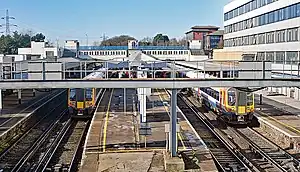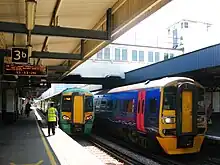Southampton Central | |
|---|---|
 | |
| General information | |
| Location | Southampton, Hampshire, England |
| Coordinates | 50°54′27″N 1°24′51″W / 50.9075°N 1.4141°W |
| Grid reference | SU41191223 |
| Managed by | South Western Railway |
| Platforms | 5 |
| Other information | |
| Station code | SOU |
| Classification | DfT category B |
| History | |
| Original company | London and South Western Railway |
| Pre-grouping | London and South Western Railway |
| Post-grouping | Southern Railway |
| Key dates | |
| 1 November 1895 | Opened (Southampton West) |
| 1934–1935 | Enlarged |
| 7 July 1935 | Renamed (Southampton Central) |
| 10 July 1967 | Renamed (Southampton) |
| 29 May 1994[1] | Renamed (Southampton Central) |
| Passengers | |
| 2018/19 | |
| Interchange | 1.619 million |
| 2019/20 | |
| Interchange | |
| 2020/21 | |
| Interchange | |
| 2021/22 | |
| Interchange | |
| 2022/23 | |
| Interchange | |
| Notes | |
Passenger statistics from the Office of Rail and Road | |
Railway lines in and around Southampton | ||||||||||||||||||||||||||||||||||||||||||||||||||||||||||||||||||||||||||||||||||||||||||||||||||||||||||||||||||||||||||||||||||||||||||||||||||||||||||||||||||||||||||||||||||||||||||||||||||||||||||||||||||||||||||||||||||||||||||||||||||||||||||||||||||||||||||||||||||||||||||||||||||||||||||||||||||||||||||||||||||||||||||
|---|---|---|---|---|---|---|---|---|---|---|---|---|---|---|---|---|---|---|---|---|---|---|---|---|---|---|---|---|---|---|---|---|---|---|---|---|---|---|---|---|---|---|---|---|---|---|---|---|---|---|---|---|---|---|---|---|---|---|---|---|---|---|---|---|---|---|---|---|---|---|---|---|---|---|---|---|---|---|---|---|---|---|---|---|---|---|---|---|---|---|---|---|---|---|---|---|---|---|---|---|---|---|---|---|---|---|---|---|---|---|---|---|---|---|---|---|---|---|---|---|---|---|---|---|---|---|---|---|---|---|---|---|---|---|---|---|---|---|---|---|---|---|---|---|---|---|---|---|---|---|---|---|---|---|---|---|---|---|---|---|---|---|---|---|---|---|---|---|---|---|---|---|---|---|---|---|---|---|---|---|---|---|---|---|---|---|---|---|---|---|---|---|---|---|---|---|---|---|---|---|---|---|---|---|---|---|---|---|---|---|---|---|---|---|---|---|---|---|---|---|---|---|---|---|---|---|---|---|---|---|---|---|---|---|---|---|---|---|---|---|---|---|---|---|---|---|---|---|---|---|---|---|---|---|---|---|---|---|---|---|---|---|---|---|---|---|---|---|---|---|---|---|---|---|---|---|---|---|---|---|---|---|---|---|---|---|---|---|---|---|---|---|---|---|---|---|---|---|---|---|---|---|---|---|---|---|---|---|---|---|---|---|---|---|---|---|---|---|---|---|---|---|---|---|---|---|---|---|---|---|
| ||||||||||||||||||||||||||||||||||||||||||||||||||||||||||||||||||||||||||||||||||||||||||||||||||||||||||||||||||||||||||||||||||||||||||||||||||||||||||||||||||||||||||||||||||||||||||||||||||||||||||||||||||||||||||||||||||||||||||||||||||||||||||||||||||||||||||||||||||||||||||||||||||||||||||||||||||||||||||||||||||||||||||
Southampton Central railway station is a main line station serving the city of Southampton in Hampshire, southern England. It is on the South West Main Line and also serves the Wessex Main Line and the West Coastway Line. The station is approached from the London direction by passing through Southampton Tunnel and is 79 miles 19 chains (127.5 km) measured from London Waterloo.[note 1]
The station is managed by South Western Railway who operate the majority of services, including frequent trains between here and London Waterloo, Weymouth and Portsmouth & Southsea. Other operators are CrossCountry (providing services between here and Bournemouth, Birmingham New Street and Manchester Piccadilly, Great Western Railway (between here and Portsmouth Harbour, Bristol Temple Meads and Cardiff Central) and Southern, which links Southampton and London Victoria, East Croydon, Gatwick Airport and Brighton.
History

Southampton Central station was opened as Southampton West in 1895, to replace the smaller nearby West End station (originally named Blechynden when it opened in 1847).[2] The station was on the seafront, specifically the stretch of water known as West Bay, with the water reaching right up to the southern edge of the platforms at high tide. A series of land reclamation projects to expand the docks, largely funded by the London and South Western Railway, culminated in the building of the vast "New Docks" (now Western Docks) between 1927 and 1934, which led to all of West Bay being reclaimed and the station becoming landlocked. The new land and the demand for new lines allowed the station to be enlarged and redeveloped in 1934–1935 (from two platforms to four), and it became 'Southampton Central'.[3] The new station buildings were largely constructed from concrete in the art deco style.[4]
An air raid on 23 November 1940, damaged the buildings alongside platform one.[4] The station was hit by two German parachute mines on 22 July 1941, which destroyed the ticket hall on platform four and damaged the island platform.[4]
In preparation for the closure of Southern Terminus station near the docks in 1966, alterations were made to the station's parcel handling facilities to allow it to handle increased volume.[5] In 1967, soon after the closure of Southampton Terminus, the station was rebuilt, losing its clocktower which was replaced with an office block.[5] At this point it was renamed 'Southampton',[5] although in 1994 was once again renamed to 'Southampton Central'.[6]
A partnership between Network Rail, South West Trains and Southampton City Council saw a £3 million investment in the refurbishment of the station entrances and improved passenger facilities which was completed in 2012.[7]
Platform layout
All the platforms are split into two sections, A at the east and B at the west, allowing two services to occupy a platform at the same time, or to allow for trains dividing into two portions or attaching to make one train. This dual use occurs throughout the day on platforms 2 and 3, and in peak hours on platforms 1 and 4.
Platforms 1 and 4 are side platforms facing the fast lines. These platforms accommodate CrossCountry's service between Manchester Piccadilly and Bournemouth; Great Western Railway's service between Cardiff Central and Portsmouth Harbour; and fast services between London Waterloo and Weymouth operated by South Western Railway.[8]
Platforms 2 and 3 are on an island, facing the slow lines. Services typically serving these platforms include South Western Railway's local services between Romsey and Salisbury, and between here and Portsmouth & Southsea. Southern services between here and either London Victoria or Brighton also serve these platforms.
There is also an ex-Red Star Parcels bay on the Bournemouth end of platform 4. Previously numbered as platform 5, stopping services between here and Brockenhurst used this platform, but the platform can no longer be used for passenger services due to the lack of a proper starting signal. It is now used for the stabling of spare units. Up and down goods loops are located a short distance to the west of the station. These allow terminating trains to clear the platforms for through services if required, and also to allow passenger services to pass freight or empty coaching stock trains.[9]
Services

Southampton Central has two trains an hour to London Waterloo, which take approximately 1 h 20 minutes.
Romsey can be reached from Southampton Central using trains departing in both directions, by South Western Railway via Chandler's Ford in the up direction and by South Western Railway and Great Western Railway via Redbridge in the down.
At the station, South Western Railway offer the following in their normal Monday to Friday off-peak service pattern:
- 2 tph to London Waterloo (fast)
- 1 tph to Weymouth
- 1 tph to Poole
- 1 tph to Winchester (stopping)
- 1 tph to Bournemouth (stopping)
- 1 tph to Portsmouth and Southsea/Portsmouth Harbour (stopping)
- 1 tph to Romsey via St Denys
- 1 tph to Salisbury via Redbridge and Romsey
Southern offer the following in their normal Monday to Friday off-peak service pattern:[10]
- 1 tph to Brighton via Worthing
- 1 tph to London Victoria via Horsham
Great Western Railway offer the following in their normal Monday to Friday off-peak service pattern:
- 1 tph to Cardiff Central
- 1 tph to Portsmouth Harbour
CrossCountry offer the following in their normal Monday to Friday off-peak service pattern:
- 1tph to Bournemouth
- 1tph to Manchester Piccadilly
In December 2007, a number of changes were made to South West Trains, First Great Western and Southern services. The Waterloo to Southampton Central stopping service was extended to Poole, replacing in part the former Brockenhurst to Wareham stopping service. The former Poole train was extended to Weymouth.
The Totton to Romsey shuttle and the Salisbury to Southampton Central portion of the First Great Western Westbury to Southampton Central service were replaced by a South West Trains Salisbury to Romsey via Southampton Central and Chandlers Ford service, which calls at Romsey twice on its journey.[11][12] Southern introduced a new service from Southampton Central to Brighton, and the service to London Victoria now runs via Horsham rather than via Hove.
In December 2008, CrossCountry launched its new timetable with most trains operating between Bournemouth and Manchester Piccadilly, with one service originating at Nottingham and one service on Saturdays terminating at Newcastle.[13] During a short period in the summer, there was also a single service on Saturdays to Leeds. As of December 2023, an hourly CrossCountry train runs from Bournemouth to Manchester Piccadilly, via Coventry, calling at Southampton Central. There were also around six trains per day in each direction on the Reading to Newcastle route, via Doncaster, which occasionally extended to Southampton Central, but no longer operates.[14]
Connections
As well as services to the wider area, there are bus services connecting the station to:
- the city centre
- the Isle of Wight Red Funnel and Blue Funnel ferries
- the National Oceanography Centre
- Southampton Airport
- the University of Southampton's Highfield Campus
Notes
References
- ↑ Butt, R.V.J. (1995). The Directory of Railway Stations, Patrick Stephens Ltd, Sparkford, ISBN 1-85260-508-1, p. 214.
- ↑ Moody, Bert (1997). Southampton's Railways. Atlantic Publishers. p. 63. ISBN 0906899788.
- ↑ Moody, Bert (1997). Southampton's Railways. Atlantic Publishers. p. 67. ISBN 0906899788.
- 1 2 3 Moody, Bert (1997). Southampton's Railways. Atlantic Publishers. pp. 69–71. ISBN 0906899788.
- 1 2 3 Moody, Bert (1997). Southampton's Railways. Atlantic Publishers. p. 74. ISBN 0906899788.
- ↑ Moody, Bert (1997). Southampton's Railways. Atlantic Publishers. p. 144. ISBN 0906899788.
- ↑ "Planning Southampton City Centre City Centre Action Plan, Part C" (PDF). Southampton City Council. Retrieved 4 January 2023.
- ↑ "South Western Railway timetable Southampton Central-London Waterloo" (PDF).
- ↑ Network Rail Sectional Appendix Wessex, Network Rail 2018
- ↑ GB eNRT 2015-16 Edition, Table 165 (Network Rail)
- ↑ "Timetable changes for December – South West Trains". Archived from the original on 13 October 2007.
- ↑ ""First Great Western – Draft December 07 to May 08 Timetable"" (PDF). Archived (PDF) from the original on 17 May 2011.
- ↑ "CrossCountry December 2008 timetable" (PDF). Archived from the original on 7 August 2011. Retrieved 22 December 2008.
- ↑ "CrossCountry December 2023 timetable" (PDF). Retrieved 7 December 2023.
External links
- Train times and station information for Southampton Central railway station from National Rail
- Eighty years since Southampon West station became Southampton Central (28 December 2015)